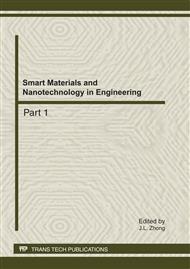p.250
p.257
p.263
p.270
p.276
p.280
p.287
p.292
p.297
EUK1111 Attenuates Scopolamine-Induced Learning Deficits in the Passive Avoidance Test
Abstract:
The aim of the experiment was to investigate the effects of the EUK1111 on passive avoidance of amnestic mice model induced by scopolamine. Five groups were divided: Control, model, model + high concentration (260 mg/kg), model + middle concentration (104.2 mg/kg) and model + low concentration (5.2 mg/kg). An open field experiment was conducted to test the locomotor activity after EUK1111 was taken orally 30 days. Scopolamine was injected intraperitoneal (1.5 mg/kg ) 10 minutes before passive avoidance test was conducted. There were no significant difference among the groups on move time, total moves, move velocity and move distance (P > 0. 05). However, in passive avoidance test, the latencies to dark side were significantly longer in model + high concentration group, model + middle concentration group than model group ( P < 0. 05). It indicates that EUK1111 may attenuate scopolamine induced learning deficits.
Info:
Periodical:
Pages:
276-279
Citation:
Online since:
September 2011
Authors:
Keywords:
Price:
Сopyright:
© 2012 Trans Tech Publications Ltd. All Rights Reserved
Share:
Citation:


